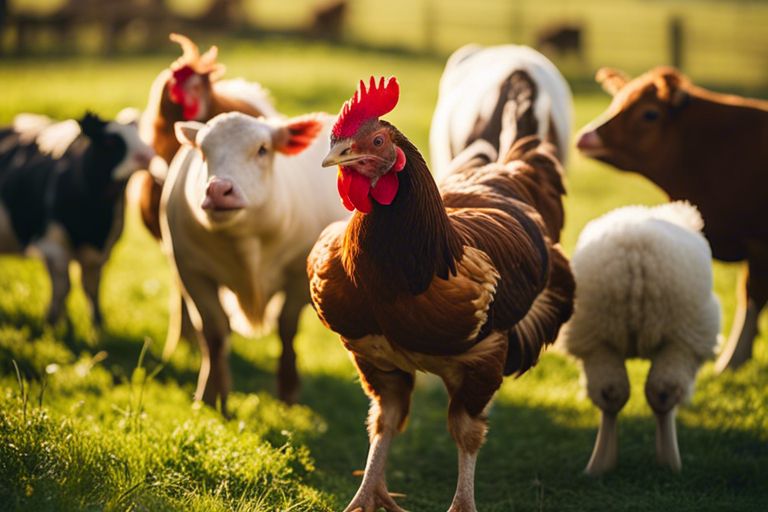It’s imperative to recognize the value of rare and endangered livestock breeds as they play a crucial role in maintaining biodiversity and preserving our agricultural heritage. These rare breeds often possess unique traits and characteristics that make them well suited for specific environments and purposes. By highlighting their importance and advocating for their protection, we can help ensure the long-term survival of these invaluable genetic resources. In this blog post, we will explore some of the rare and endangered livestock breeds that are worth preserving for future generations.

The Role of Conservation Programs
In-Situ vs. Ex-Situ Conservation Efforts
Efforts to preserve rare and endangered livestock breeds primarily fall into two categories: in-situ and ex-situ conservation. In-situ conservation involves the protection and management of populations within their natural habitats, while ex-situ conservation focuses on maintaining breeds outside of their native environment, such as in dedicated breeding facilities or zoos. Both approaches play a crucial role in ensuring the survival of these genetically important breeds.
Success Stories and Challenges
To effectively conserve rare livestock breeds, it is vital to understand both the success stories and challenges that conservation programs face. Success stories highlight the positive outcomes of conservation efforts, such as increasing populations and genetic diversity. However, challenges such as limited funding, lack of public awareness, and conflicting interests pose significant obstacles that must be addressed to ensure the long-term sustainability of these breeds.
Success: Some successful conservation programs have focused on creating partnerships with local communities, governments, and agricultural organizations to raise awareness and secure resources for breed preservation. By implementing sustainable breeding strategies and promoting the economic benefits of rare breeds, these programs have been able to make significant strides in safeguarding the genetic diversity of endangered livestock populations.

Characteristics of Rare Livestock Breeds
Adaptive Traits and Historical Significance
One of the key reasons rare livestock breeds are worth preserving is their adaptive traits and historical significance. These breeds have evolved over centuries to thrive in specific environments and have developed unique characteristics that make them valuable for conservation efforts.
Economic and Cultural Value
Value. Rare livestock breeds also hold great economic and cultural value. From a practical standpoint, these breeds often possess traits that make them well-suited for sustainable farming practices. Additionally, they play a crucial role in maintaining biodiversity in our food systems, which is necessary for the resilience of agriculture in the face of changing environmental conditions.
Significance. Furthermore, these breeds have cultural significance as they are often deeply intertwined with local heritage and traditions. Preserving them ensures that these cultural connections are not lost and that future generations can continue to benefit from the unique qualities these breeds offer.

Strategies for Preservation
Breeding Programs and Genetic Banks
For successful preservation of rare and endangered livestock breeds, strategic breeding programs and the establishment of genetic banks are crucial. These programs involve carefully selecting breeding pairs to maintain genetic diversity and prevent inbreeding, ensuring the long-term viability of the breeds. Genetic banks store genetic material such as semen and embryos for future use, safeguarding the valuable genetic heritage of these breeds.
Public Awareness and Education Initiatives
Preservation of rare livestock breeds also relies heavily on public awareness and education initiatives. Educating the public about the importance of these breeds in terms of genetic diversity, cultural heritage, and sustainable agriculture is crucial. Awareness campaigns can help garner support for conservation efforts, encourage breeders to choose rare breeds, and promote their products in the market.
Additionally, educational programs targeting farmers, schools, and the general public can teach about the unique characteristics and benefits of rare breeds, fostering appreciation and interest in their conservation. By raising awareness and providing knowledge, these initiatives play a critical role in securing the future of endangered livestock breeds.
Conclusion
Now more than ever, it is crucial to prioritize the preservation of rare and endangered livestock breeds. These breeds not only hold valuable genetic diversity but also play a crucial role in maintaining agricultural sustainability. By supporting and conserving these breeds, we are safeguarding our agricultural heritage and ensuring a resilient future for our livestock industry. It is imperative that we continue to raise awareness, support breeding programs, and promote sustainable practices to protect these valuable animal breeds for future generations.
FAQ
Q: Why is it important to preserve rare and endangered livestock breeds?
A: Preserving rare and endangered livestock breeds is crucial for maintaining biodiversity, genetic diversity, and cultural heritage in the agriculture industry.
Q: How do rare and endangered livestock breeds contribute to sustainable agriculture?
A: Rare and endangered livestock breeds often possess unique traits that can make them well-suited for specific environments or production systems, which can contribute to sustainable agriculture practices.
Q: What are some examples of rare and endangered livestock breeds?
A: Examples of rare and endangered livestock breeds include the American Mammoth Jackstock, San Clemente Island Goat, and Randall Lineback Cattle.
Q: How can individuals support the preservation of rare and endangered livestock breeds?
A: Individuals can support the preservation of rare and endangered livestock breeds by choosing products from these breeds, promoting awareness, and financially supporting conservation efforts.
Q: What are the challenges faced in preserving rare and endangered livestock breeds?
A: Challenges in preserving rare and endangered livestock breeds include limited genetic diversity, loss of traditional knowledge, and economic factors that favor more common breeds.
Q: Are there any organizations dedicated to the preservation of rare and endangered livestock breeds?
A: Yes, there are organizations such as The Livestock Conservancy and Rare Breeds Canada that are dedicated to conserving and promoting rare and endangered livestock breeds.
Q: What are the long-term benefits of preserving rare and endangered livestock breeds?
A: Preserving rare and endangered livestock breeds can lead to a more resilient food system, increased agricultural diversity, and the continued existence of valuable genetic resources for future generations.











